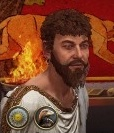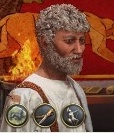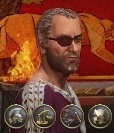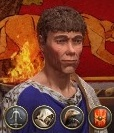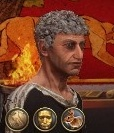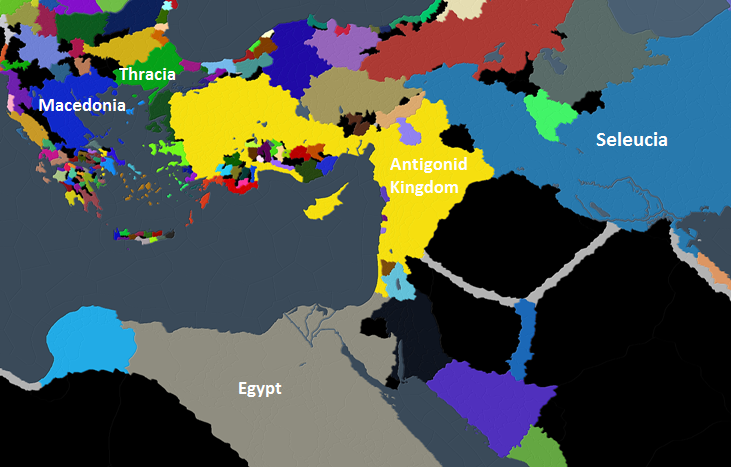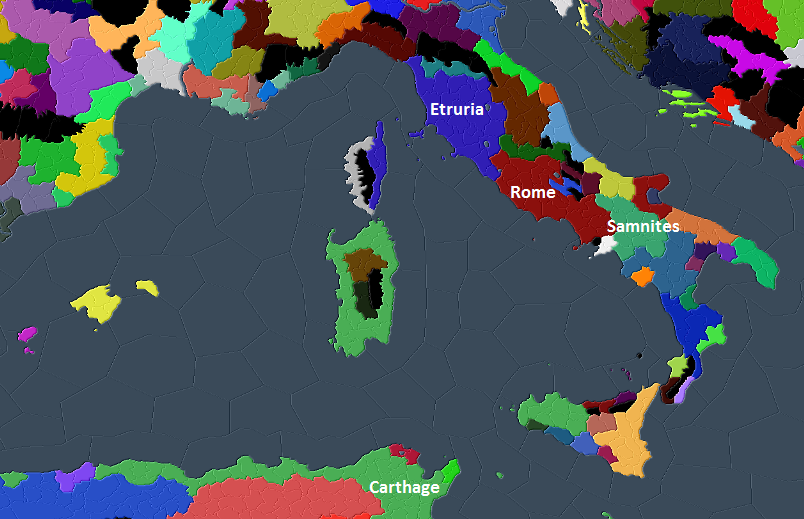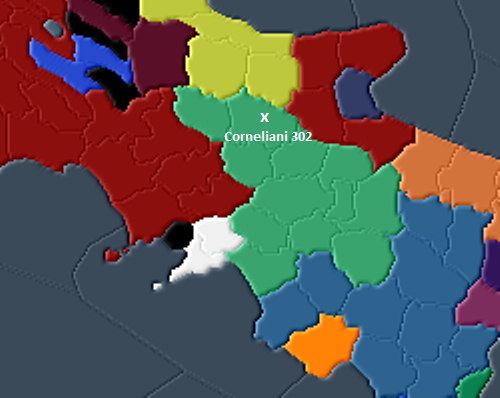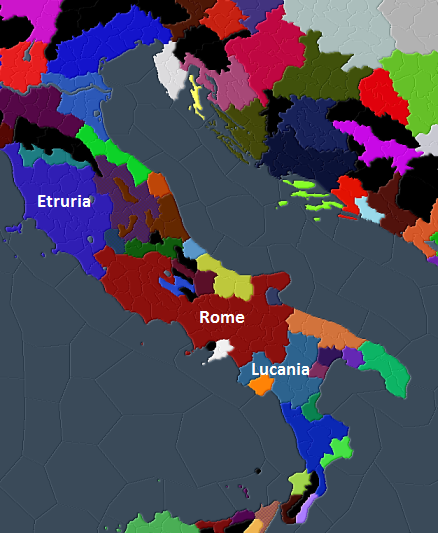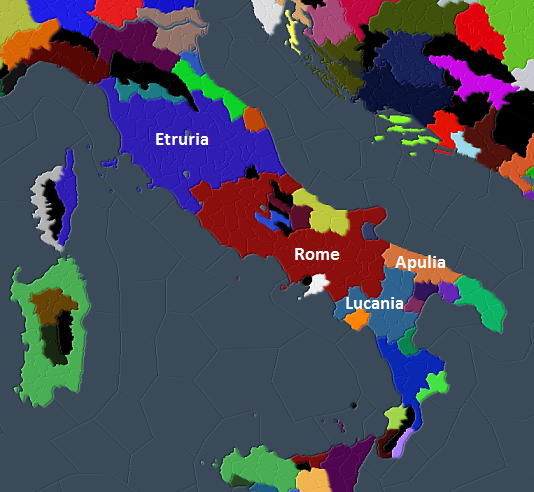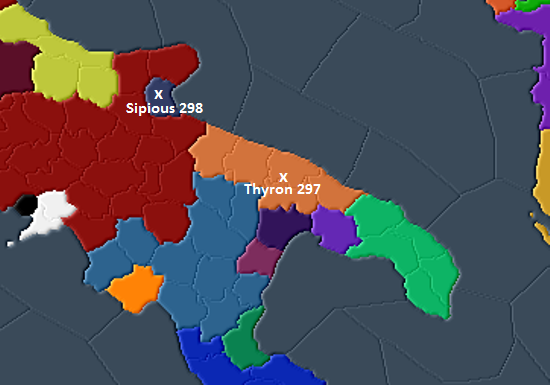
Table of Content
Chapter 01 - Prologue
Chapter 02 - The Mediterranean World around 300 (The East)
Chapter 03 - The Mediterranean World around 300 (The West)
Chapter 04 - The Third Samnite War (304 - 301)
Chapter 05 - Central Italy and the Sabinian Campaign (303 - 300)
Chapter 06 - The Roman-Apulian War (299 - 297)
Chapter 07 - Developments in Roman Society (304 - 296)
Chapter 08 - The Lucanian Campaign (295)
Chapter 09 - Italiote Diplomacy (294)
Chapter 10 - The Tuscian War (294 - 293)
Chapter 11 - The Elean Campaign (290 - 289)
Chapter 12 - The Second Etruscan War (289 - 287)
Chapter 13 - The Tarentinian War (287 - 285)
Chapter 14 - Gallic Affairs (283 - 282)
Chapter 15 - The Third Etrurian War (282 - 280)
Chapter 16 - The Bruttian War (279 - 277)
Chapter 17 - Developments in Roman Society (295 - 277)
Chapter 18 - Beyond Italy - Looking for a Strategy
Chapter 19 - Assimilation of Corsica (282 - 275)
Chapter 20 - The First Punic War (275 - 274)
Chapter 21 - Sardinian Unrest (273)
Chapter 22 - The Sikulian War (272 - 271)
Chapter 23 - Subjugation of Sardinia (270 - 269)
Chapter 24 - The Second Punic War (269 - 267)
Chapter 25 - Sicily and the begin of the Interlude (266 - 265)
Chapter 26 - Landfall in Illyria (264 - 263)
Chapter 27 - The Abrian Campaign (263 - 262)
Chapter 28 - Developments in the Republic (276 - 262)
Chapter 29 - The Cavian Campaign (261 - 260)
Chapter 30 - The Ligurian War (260 - 259)
Chapter 31 - The Daorsian Campaign (259 - 258)
Chapter 32 - The Taulantian Campaign (258 - 257)
Chapter 33 - Central Illyria and the Issa Civil War (256)
Chapter 34 - The northern Alliance (255 - 253)
Chapter 35 - The Ilvatian Campaign (252 - 251)
Chapter 36 - End of the Interlude (304 - 250)
Chapter 37 - The Epirote War (249 - 248)
Chapter 38 - The Macedonian War (247 - 246)
Chapter 39 - The Antigonid War (244 - 242)
Chapter 40 - Developments in the Republic (261 - 242)
Chapter 41 - The Campaign of 241
Chapter 42 - The Second Macedonian War (240 - 238)
Chapter 43 - The Argolid War (238 - 236)
Chapter 44 - Downfall of the Poleis (236 - 235)
Chapter 45 - The Thessalian War (234 - 233)
Chapter 46 - Into Thracia (232)
Chapter 47 - Venetian Containment (229)
Chapter 48 - The Valley Campaign (228 - 227)
Chapter 49 - The Island Campaign (226)
Chapter 50 - The Second Antigonid War (225 - 224)
Chapter 51 - Cornelian Dialogue (224 - 223)
Chapter 52 - The Dardanian-Sardinian War (222 - 221
Chapter 53 - Developments in the Republic (241 - 221)
Chapter 54 - The Second Thessalian War (220 - 218)
Chapter 55 - The Third Antigonid War (218 - 217)
Chapter 56 - End of the Greek Campaign (213 - 211)
Chapter 57 - Entrance to Hispania (210)
Chapter 58 - The Indigetien Campaign (209 - 208)
Chapter 59 - Across the Iberus (207)
Chapter 60 - The Sedetanian War (205 - 203)
Chapter 61 - The Ilergetian Campaign (202 - 201)
Chapter 62 - Rome and the Mediterranean World in 200
Chapter 63 - The Sibuzatian Campaign (199)
Chapter 64 - From Coast to Coast (197)
Chapter 65 - Toward the Padus Valley (196 - 194)
Chapter 66 - The Taurinian Campaign (193)
Chapter 67 - Transpadana subdued (190 - 189)
Chapter 68 - The Getae War (188-187)
Chapter 69 - The Olcadian Campaign (186)
Chapter 70 - The Campaign of 185
Chapter 71 - Mallorca and Menorca (184 - 183)
Chapter 72 - The Second Olcadian Campaign (182 - 181)
Last edited:
- 1


